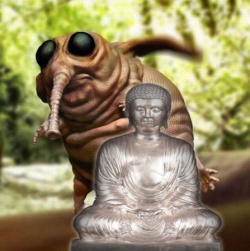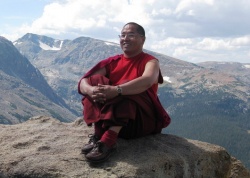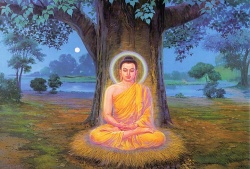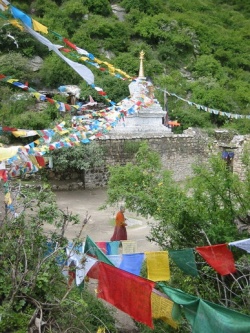Exploration and Conquest
by: Julia Hardy
Ashoka was a key figure in the transition of Buddhism from a local religion to a force that transformed Asia. Ruler of much of the Indian subcontinent from 260 to 232 B.C.E., he was the grandson of the founder of the Mauryan Empire, Chandragupta, and the son of Bindusara, another great conqueror. Under Ashoka, the Mauryan Empire would encompass almost the entire Indian subcontinent and extend to the northwest beyond Kashmir.
Eight years into his reign, Ashoka waged a bloody war on Kalinga, a region south of Magadha along the eastern coast. According to legends and a few remaining stone inscriptions, when Ashoka looked back on the destruction of this war he experienced remorse. He regretted the deaths of so many good people, and the heartache of so many more who had lost loved ones. Ashoka's remorse led him to take more seriously the Buddhist religion to which he had converted a few years earlier, possibly at the urging of his wife.
Ashoka had thousands of pillars and rocks inscribed with messages expounding the Buddhist dharma placed throughout his empire and beyond, stating, "This Dharma edict has been written on stone so that it might endure long and that my descendants might act in conformity with it." The language of the inscriptions varied according to where they were located; there is even one written in Aramaic and Greek. In the future, Ashoka announced, he would undertake "conquest by righteousness (dharma)" instead of war. Dharma, in this case, refers to the moral teachings of Buddhism rather than to a philosophy or meditative practice aimed toward enlightenment.
One of Ashoka's edicts encouraged respect and obedience of parents, elders, teachers, ascetics, and Brahmin, and respect for friends and servants. Other virtues he had inscribed were kindness, self-examination, truthfulness, gratitude, purity of heart, enthusiasm, loyalty, self-control, and frugality. Character flaws to avoid included violence, anger, cruelty, arrogance, laziness, and jealousy. The inscriptions also advocated religious tolerance, saying that no one should claim one religion to be better than another because doing so will only harm one's own religion, and that contact between different religions is good.
Ashoka also had his devotion to caring for his people inscribed in stone, saying that they were like his children, and that there was no work more rewarding to him than looking out for their welfare. He caused fruit and shade trees to be planted and wells dug to provide places of rest and nourishment for travelers, and he provided medical treatment for humans and animals. He wrote that he had instructed his officials to be fair and impartial, and that he would send inspectors to make sure that they were. He also announced that he had sent people to teach the dharma across his kingdom.
In addition to having the stone inscriptions created, Ashoka gave financial support to monks, built monasteries, and made pilgrimages to important sites in the life of the Buddha, such as his birthplace, the place of his enlightenment, and the location of his first sermon. Following his lead, pilgrimages to these sacred places became a favored practice among Buddhist devotees, and eventually large monastery complexes grew up on these sites.
According to legend, Ashoka gathered the remains of the Buddha and redistributed them to 84,000 stupas throughout his empire. Legends also say that he convened the Third Buddhist Council, to reaffirm the rules of monastic discipline, eliminate some monks whose conduct was deemed unacceptable, and reunify the other disparate communities of Buddhist monks. He also sent missionaries to spread word of Buddhism to other lands, including a son, Mahinda, who was a monk, and a daughter who was a nun.
Within fifty years after Ashoka's death, the Mauryan Empire fell, but rulers of various Indian kingdoms continued to support Buddhism. A body of legends about his life and rule emerged and spread to other Buddhist countries, persisting for centuries, and later rulers sometimes modeled themselves after Ashoka. The method of inscribing one's intentions in stone, which also served to mark one's territory (and probably was in use before Ashoka's time), became a standard political strategy in South Asia.
By the end of the 12th century C.E., Buddhism had virtually died out in India. A variety of factors are responsible for this, including a resurgence of Hinduism, which incorporated many of the innovations of Buddhism, and the Muslim invasions. In the meantime, Buddhism had become well-established in Southeast Asia, Tibet, China, Korea, and Japan.
As Buddhism spread throughout Asia, rulers of other countries took Ashoka as a model, and many regarded him as the exemplary Buddhist ruler. In powerful kingdoms within the countries we now call Sri Lanka, Burma (Myanmar), Thailand, Cambodia, Laos, Korea, Japan, and Tibet, Buddhism was established and grew with the benefit of official support similar to the support that Ashoka had given, including contributions of land, buildings, and other endowments. Buddhism was attractive to rulers because Buddhism was popular with the people, and because support of Buddhism could help legitimate their rule. It is also possible that rulers were attracted by the fact that both Siddhartha Gautama and Ashoka were scions of powerful military and governing families.
Some rulers were even thought of, or thought of themselves as, living deities, as chakravartin-raja, or wheel-turning kings. The term, which originated in pre-Buddhist India, first referred to a universal ruler who would bring morality and peace to the entire world. Within Buddhism, the term originally referred to one who renounced the role of ruler, as the Buddha had done. The term later was applied to Ashoka, who had spread the dharma but continued to rule as a king, not a monk. In China the Buddhist emperor Wu of the Liang dynasty (r. 501-549 C.E.) was called a cakravartin-raja because of his generous support of Buddhism. In contrast, the Empress Wu of the Tang dynasty (r. 684-704 C.E.) called herself a cakravartin-raja, and even had a scripture fabricated by her lover, a Buddhist monk, to legitimate her right to rule.



